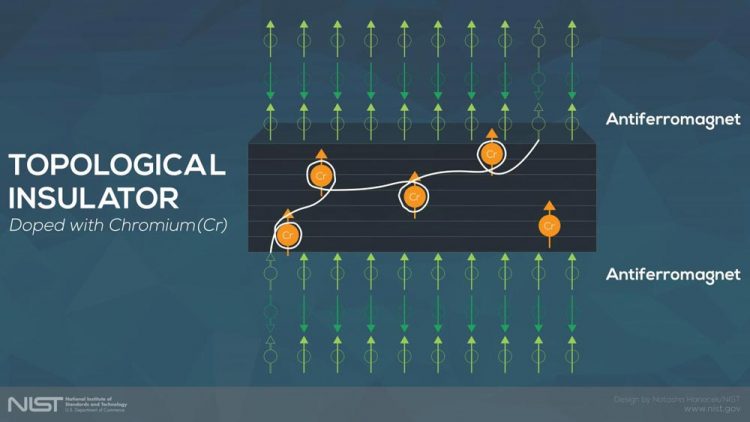NIST collaboration heats up exotic topological insulators

This topological insulator, doped with chromium (Cr) atoms, conducts electricity on its surface and possesses desirable magnetic properties at a higher range of temperatures than before when sandwiched between magnetic materials known as ferromagnets. Credit: Hanacek/NIST
This was clearly on display in a novel experiment at the National Institute of Standards and Technology (NIST) that was performed by a multi-institutional collaboration including UCLA, NIST and the Beijing Institute of Technology in China.
Topological insulators are a new class of materials that were discovered less than a decade ago after earlier theoretical work, recognized in the 2016 Nobel Prize in physics, predicted they could exist. The materials are electrical insulators on the inside and they conduct electricity on the outer surface. They are exciting to computer designers because electric current travels along them without shedding heat, meaning components made from them could reduce the high heat production that plagues modern computers.
They also might be harnessed one day in quantum computers, which would exploit less familiar properties of electrons, such as their spin, to make calculations in entirely new ways. When TIs conduct electricity, all of the electrons flowing in one direction have the same spin, a useful property that quantum computer designers could harness.
The special properties that make TIs so exciting for technologists are usually observed only at very low temperature, typically requiring liquid helium to cool the materials. Not only does this demand for extreme cold make TIs unlikely to find use in electronics until this problem is overcome, but it also makes it difficult to study them in the first place.
Furthermore, making TIs magnetic is key to developing exciting new computing devices with them. But even getting them to the point where they can be magnetized is a laborious process. Two ways to do this have been to infuse, or “dope,” the TI with a small amount of magnetic metal and/or to stack thin layers of TI between alternating layers of a magnetic material known as a ferromagnet. However, increasing the doping to push the temperature higher disrupts the TI properties, while the alternate layers' more powerful magnetism can overwhelm the TIs, making them hard to study.
To get around these problems, UCLA scientists tried a different substance for the alternating layers: an antiferromagnet. Unlike the permanent magnets on your fridge, whose atoms all have north poles that point in the same direction, the multilayered antiferromagnetic (AFM) materials had north poles pointing one way in one layer, and the opposite way in the next layer. Because these layers' magnetism cancels each other out, the overall AFM doesn't have net magnetism–but a single layer of its molecules does. It was the outermost layer of the AFM that the UCLA team hoped to exploit.
Fortunately, they found that the outermost layer's influence magnetizes the TI, but without the overwhelming force that the previously used magnetic materials would bring. And they found that the new approach allowed the TIs to become magnetic and demonstrate all of the TI's appealing hallmarks at temperatures far above 77 Kelvin–still too cold for use as consumer electronics components, but warm enough that scientists can use nitrogen to cool them instead.
“It makes them far easier to study,” says Alex Grutter of the NIST Center for Neutron Research, which partnered with the UCLA scientists to clarify the interactions between the overall material's layers as well as its spin structure.
“Not only can we explore TIs' properties more easily, but we're excited because to a physicist, finding one way to increase the operational temperature this dramatically suggests there might be other accessible ways to increase it again. Suddenly, room temperature TIs don't look as far out of reach.”
###
Paper: Q.L. He, X. Kou, A.J. Grutter, G. Yin, L. Pan, X. Che, Y. Liu, T. Nie, B. Zhang, S.M. Disseler, B.J. Kirby, W. Ratcliff II, Q. Shao, K. Murata, X. Zhu, G. Yu, Y. Fan, M. Montazeri, X. Han, J.A. Borchers and K.L. Wang. Tailoring Exchange Couplings in Magnetic Topological Insulator/Antiferromagnet Heterostructures. Nature Materials, October 31, 2016. DOI: 10.1038/nmat4783
Media Contact
All latest news from the category: Materials Sciences
Materials management deals with the research, development, manufacturing and processing of raw and industrial materials. Key aspects here are biological and medical issues, which play an increasingly important role in this field.
innovations-report offers in-depth articles related to the development and application of materials and the structure and properties of new materials.
Newest articles

First-of-its-kind study uses remote sensing to monitor plastic debris in rivers and lakes
Remote sensing creates a cost-effective solution to monitoring plastic pollution. A first-of-its-kind study from researchers at the University of Minnesota Twin Cities shows how remote sensing can help monitor and…

Laser-based artificial neuron mimics nerve cell functions at lightning speed
With a processing speed a billion times faster than nature, chip-based laser neuron could help advance AI tasks such as pattern recognition and sequence prediction. Researchers have developed a laser-based…

Optimising the processing of plastic waste
Just one look in the yellow bin reveals a colourful jumble of different types of plastic. However, the purer and more uniform plastic waste is, the easier it is to…



